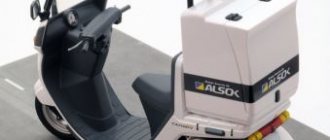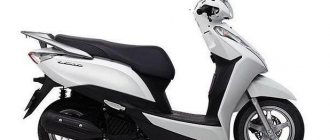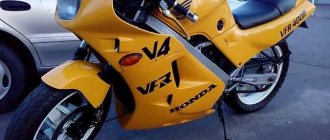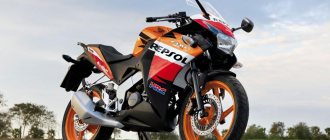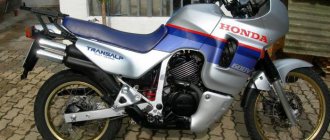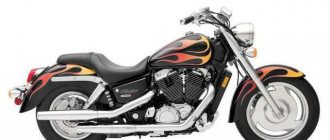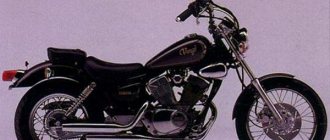At the initial stage of the evolution and development of two-wheeled vehicles, motorcycle manufacturers preferred to make exclusively sports bikes. There were reasons for this, of course, because to popularize motorcycle culture, motorsports was actively developing, which required the presence of high-speed models. But a little later, companies such as Harley Davidson, Honda and others realized that people needed some kind of quiet bike, for small summer trips and banal “rides”. This is how a class of motorcycles called a cruiser was born, which is translated from English as “travel”, “flight”. Today we would like to introduce you to one of the representatives of this class, namely the Honda Steed 400 (Honda Steed 400).
For whom
Here are the main features of the Honda Steed 400:
- 31 hp and 33 Nm;
- average dimensions for the class;
- small tank 11 l.
The motorcycle is not particularly powerful, which makes it a good choice for novice drivers. At the same time, such a machine will be quite enough for those who do not need much from a bike, and they just want to ride it without haste.
Disadvantages of a motorcycle
Of course, the motorcycle is very worthy, but there are still shortcomings that cause some discomfort. Of these, we can note the small capacity of the tank. Agree, 11 liters is not so much for a cruiser, and considering that the old models had 8-liter tanks, this spoils the impression even more.
As mentioned earlier, the cruiser’s suspension causes some inconvenience, but you can get used to it. The engine power is a little more concerning. Over time, 400cc becomes not enough, so if you decide to buy this motorcycle, then it is better to go for the Steed 600.
Also, the motorcycle is not very comfortable for people with a height of more than 190 cm, since the seating position is quite low and the steering wheel is close to the seat.
Engine
The machine has a four-stroke two-cylinder V-shaped engine. Its effective volume is 398 cm³. The liquid-cooled engine produces the following maximum performance: at 6000 rpm the torque is 33 Nm, and at 7500 rpm the power reaches 31 hp. The model will accelerate to 100 km/h in 11.1 seconds, and the top speed is 130 km/h.
Dimensions and weight
The length of the bike is 2310 mm, height – 1120 mm, and width – 890 mm. The seat height of the Honda Steed 400 reaches 670 mm, and the wheelbase is 1600 mm. The bike weighs 215 kg including fuel, and the volume of its fuel tank is 11 liters. The actual fuel consumption per 100 km of road is about 4-5 liters.
Chassis and brakes
The bike has a tubular frame. It is made of steel and is not pretentious, but elegant design. There is nothing superfluous in the design. At first glance, the stylization of American-style motorcycles is noticeable. The same applies to spoked wheels and steering wheel. The latter is comfortable and has medium dimensions.
The pendulum suspension with monoshock absorber at the rear pairs well with the front telescopic forks. The drum acts as the rear brake, while the front uses a twin-piston caliper and a 296mm disc.
Remember your first bike? How did it fly, what mileage, what color? Remember how he looked at you - like a baby? Do you remember how often he sang to you in the garage? How bored were you alone in winter? No matter how much water passes under the bridge, no matter how many kilometers you travel, no matter how many motorcycles you change, you will always, always remember your first motorcycle. So, I'm a poor, horseless loser who is considering six models as contenders for his first motorcycle. Six, of which only one model will be my first bike, which I will remember with warmth and love.
How did it fly, what mileage, what color? Remember how he looked at you - like a baby? Do you remember how often he sang to you in the garage? How bored were you alone in winter? No matter how much water passes under the bridge, no matter how many kilometers you travel, no matter how many motorcycles you change, you will always, always remember your first motorcycle. So, I'm a poor, horseless loser who is considering six models as contenders for his first motorcycle. Six, of which only one model will be my first bike, which I will remember with warmth and love.
No, there will be no requests for help in choosing a bike or questions about whether I have chosen the right bike for myself. The main thing here is that I make a choice for myself. And in general, it has been done for a long time. And a reviewer for others. Love, love... When I say this word, Paris, rich buns, beautiful French women immediately appear before my eyes... This is why many people love France.
The main thing here is that I make a choice for myself. And in general, it has been done for a long time. And a reviewer for others. Love, love... When I say this word, Paris, rich buns, beautiful French women immediately appear before my eyes... This is why many people love France. Why do they love 400cc bikes so much? For reasonable prices? Taking into account the crisis and the pre-season... No, prices are biting these days. So why do you love 400cc bikes? That's right, for the sporting character! What else? That's right, kids, for the ease! The weight of such a bike rarely exceeds 160-170 kg. Fell - picked up And also? This is where individuality arises. Some people love it for their appearance, others for something else...
Why do they love 400cc bikes so much? For reasonable prices? Taking into account the crisis and the pre-season... No, prices are biting these days. So why do you love 400cc bikes? That's right, for the sporting character! What else? That's right, kids, for the ease! The weight of such a bike rarely exceeds 160-170 kg. Fell - picked up And also? This is where individuality arises. Some people love it for their appearance, others for something else...
Are there many 400cc sports? Precisely sportbikes. Let’s remove naked bikes, choppers, enduros, and tourists from the list. Let's leave only sports. And there will be six of them: Suzuki GSX-R400, Honda CBR400RR, Honda VFR400R, Honda RVF400R, Kawasaki ZXR400 and Yamaha FZR400.
So, after such a long introduction, which may not be very interesting to read, let's get straight to the cake!
First on the list is the Suzuki GSX-R400.
Wow, this little killer is the best in its class. It is listed in the Red Book because it is almost impossible to find. 1995 Suzuki GSX-R400
Doesn't look bad for a 1995? But it is not much different (in design) from the 1990 model... Well, just think, the brake discs have been restyled. Same 1990 model. In general, I don't want to give you hope of finding a good Jixer, so don't worry - I won't talk about this motorcycle. There is a lot of information about him on the Internet - search and you will find
But it is not much different (in design) from the 1990 model... Well, just think, the brake discs have been restyled. Same 1990 model. In general, I don't want to give you hope of finding a good Jixer, so don't worry - I won't talk about this motorcycle. There is a lot of information about him on the Internet - search and you will find
A little video of a little killer.
Number two is the Honda CBR400RR.
Honda CBR400RR
This bike, this one (not to be confused with the Honda CBR400R) was born in 1987. Like all 400cc bikes produced in Japan, the maximum engine power was 59 horsepower. It is simply impossible to go further - by law. The chassis fully matches the engine - it is aluminum and diagonal, with a Showa monoshock absorber and so on.
In 1991, Honda released the new CBR400RR. The chassis was new. So when you look at this bike on the market, pay attention to the chassis number. If it's not an NC29, and the seller says it's a 1996 model, don't believe it.
And again the video. There's also a bonus - the owner's post
There's also a bonus - the owner's post
Number three is the Honda VFR400R.
Honda VFR400R
What does your eye catch when you take a quick look at this bike? To the rear wheel. Well, personally, I turn to him first. It measures 18″. Looking ahead, this is one of the shortcomings of the bike. At the height of the season, God forbid, something happens to the rear wheel... You simply cannot buy such a tire.
Honda VFR400R was born in 1987, just like our previous friend. The appearance of this bike was comparable to the explosion of a bomb. Because the Japanese stormed motorcycle dealerships in droves hoping to buy this bike. In 1994, production of this model was completed, so if you look at this particular bike, pay attention to the chassis markings. If you see NC24, this is a 1987 model, if NC30 is a model after 1988 (including 1988). Well, vyfers were so popular in Japan that they are now easy to find on the secondary market. The advantage of the bike, as well as its disadvantage, is the engine. On the one hand (on the positive side), this is a powerful and revving 4-cylinder engine with a gear drive of camshafts and a cylinder block angle of 90 degrees. On the other hand, it is very complexly designed and needs to be very carefully configured and synchronized the operation of the cylinders.
Again a video And again a bonus - post from the owner
And again a bonus - post from the owner
In 1994, when they stopped making the model, the RVF400R NC35 entered the production line and this is our number four. 
Honda RVF400R
Like the VFR400R, the RVF400R is a small copy of the RVF750R. Strictly speaking, there is a huge gap between the “forefather” VFR400R and RVF400R. Well, except for the frame. She is the same as on the vyfera. But everything else is different. This bike was produced for just two years. If I had to choose between the Vyfer and the RVF400R, I would probably choose the latter. Well, at least in appearance, as many beginners do. The RVF400R does not have such round and funny headlights as the Vifer. And I’m generally silent about the other rear wheel with a diameter of 17″ (there will be no problems finding tires) and about the inverted fork with preload adjustment.
Strictly speaking, there is a huge gap between the “forefather” VFR400R and RVF400R. Well, except for the frame. She is the same as on the vyfera. But everything else is different. This bike was produced for just two years. If I had to choose between the Vyfer and the RVF400R, I would probably choose the latter. Well, at least in appearance, as many beginners do. The RVF400R does not have such round and funny headlights as the Vifer. And I’m generally silent about the other rear wheel with a diameter of 17″ (there will be no problems finding tires) and about the inverted fork with preload adjustment. For me, this is the most ideal option for a beginner. Among 400 cc ones, of course. Well, try to find it. Good luck.
For me, this is the most ideal option for a beginner. Among 400 cc ones, of course. Well, try to find it. Good luck.
Well, what about without a video? 
Whether it’s long or short, we’ve reached the fifth exhibit of our exhibition - the Kawasaki ZXR400.
In relation to this bike, you can write the word “the most” - the most evil 400 cc sport, the most sporty, the most beautiful (well, this is subjective of course), the most daring, the most. Do you want to get killed quickly? Take Zakhar. He will do his job accurately and on time.
Do you want to get killed quickly? Take Zakhar. He will do his job accurately and on time. Even though it is 400cc, it is so sporty that you won’t be able to drive it slowly. Plus it has very sharp handling. I mean, she's good, even too good. It’s easy to fall in a turn on Zakhara. In general, I repeat, if you want to kill yourself, take Zakhar
Even though it is 400cc, it is so sporty that you won’t be able to drive it slowly. Plus it has very sharp handling. I mean, she's good, even too good. It’s easy to fall in a turn on Zakhara. In general, I repeat, if you want to kill yourself, take Zakhar
Kawasaki ZXR400
And a video. You see how evil Zakhar is - I couldn’t even find a video of him standing, he drives everywhere. Just like in this video 
And the last candidate is the Yamaha FZR400.
Yamaha FZR400
This Yamaha was born in 1986. In 1988, an inertial charging system and a reinforced pendulum appeared. Further more, in 1990 a new frame appeared again, new carburetors were installed, the base and weight were reduced to 160 kg, and hallelujah - the wheel became 17″. And it was 18″. In general, this bike gives a feeling of absolute control (over it, of course) and ease of operation. Little rocket 
Video again! And a bonus - a review of models from 1988-1994
You say: “Damn, why are you silent about the dimensions?” A person under 180 tall will be more or less comfortable on all the bikes presented. Some are more convenient, some are less. It depends on the individual body structure. So before you buy, at least sit on the purchase . As for my dimensions, I am quite modest. Only 167 cm. So, in principle, I can be comfortable on each of the bikes.
A person under 180 tall will be more or less comfortable on all the bikes presented. Some are more convenient, some are less. It depends on the individual body structure. So before you buy, at least sit on the purchase . As for my dimensions, I am quite modest. Only 167 cm. So, in principle, I can be comfortable on each of the bikes.
If you are going to drive purely in the city, with rare trips out of town, or rather short trips out of town, then a Honda is preferable. It is not convenient to ride a Kawasaki in the city. Well, at least... It depends on your level of preparation... If you got on a bike for the first time, then you won’t be very comfortable riding or controlling the bike... And then get used to it and adapt.
All bikes have the same power - 59 horses. Well, plus or minus. Somehow in Japan, after 1994, they changed the maximum power... They reduced it to 53 horses. But that's not the point. The bottom line is that every bike rides differently. Honda pulls from the very bottom. But Kawasaki is not. But the ZXR400 shows that he is an athlete - a serious drawdown at low revs and pick-up at 10 thousand... That’s why I don’t advise a beginner to take Zakhar. He's going to have a hard time. 
Acceleration. This is where it gets funny. Kawasaki, even though it is the most evil, will remain at the traffic light compared to Honda. Why? Honda has a more uniform engine performance. And in general, Honda requires less concentration from the driver than Kava.
Okay, let's say you've decided on a bike. After this, you need to think about the price and cost of operation: tires, brakes, plastic. Next you need to think about equipment. But this is a topic for a separate post. I’ll just say that you shouldn’t take fabric equipment. Skin is skin.
PS Do not throw spare parts and components. This is my first experience of writing such a post.
This is my first experience of writing such a post.
